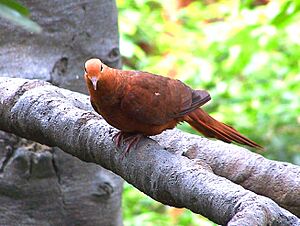Ruddy cuckoo-dove facts for kids
Quick facts for kids Ruddy cuckoo-dove |
|
|---|---|
 |
|
| Conservation status | |
| Scientific classification | |
| Genus: |
Macropygia
|
| Species: |
emiliana
|
| Subspecies | |
|
See text |
|
The ruddy cuckoo-dove (Macropygia emiliana) is a type of bird that belongs to the Columbidae family, which includes doves and pigeons. This bird is a medium-sized dove with reddish-brown feathers. You can find it in countries like Brunei, Indonesia, and Malaysia. Scientists have checked on its numbers and say it is a species of least concern, meaning it is not currently in danger of disappearing.
Contents
What is a Ruddy Cuckoo-Dove?
The ruddy cuckoo-dove is a beautiful bird known for its reddish-brown color. It is a medium-sized dove, usually measuring about 30 to 37 centimeters (about 12 to 15 inches) long. Its head is a uniform ruddy (reddish) color. The chest has a purplish-brown color with black bars, and its neck shines with a pinkish glow.
How to Identify a Ruddy Cuckoo-Dove
This dove has a long, thin tail. Unlike some other doves, its tail does not have any light grey or white tips. The feathers covering the center of its tail are also a uniform ruddy color, without any black stripes. Young ruddy cuckoo-doves look similar to the adult females but have more noticeable stripes on their bodies.
Where Does the Ruddy Cuckoo-Dove Live?
The ruddy cuckoo-dove lives in parts of Southeast Asia. You can find these birds in Brunei, Indonesia, and Malaysia. They are often found on islands like Borneo Island and the islands off the south and west coasts of Sumatra. While they might be hard to spot sometimes, they are quite common in these areas.
How Scientists Study the Ruddy Cuckoo-Dove
Scientists use special names to classify animals, which helps them organize and study different species. The ruddy cuckoo-dove was first described by a French biologist named Charles Lucien Jules Laurent Bonaparte in 1854. This means he was the first to officially name and describe it for science.
How Do Scientists Name Animals?
Scientists group animals based on how they are related. The ruddy cuckoo-dove's scientific name is Macropygia emiliana. The first part, Macropygia, is its genus, which is a group of closely related species. The second part, emiliana, is its specific name. Sometimes, scientists discover that a species they thought was one kind is actually two or more different kinds. This happened with the ruddy cuckoo-dove, which was separated from another bird called the slender-billed cuckoo-dove in 2003.
Is the Ruddy Cuckoo-Dove in Danger?
The ruddy cuckoo-dove is currently listed as a species of "least concern" by the International Union for Conservation of Nature (IUCN). This is good news, as it means the bird is not considered to be at high risk of extinction right now.
Why is it "Least Concern"?
There are a few reasons why the ruddy cuckoo-dove is not considered endangered:
- Wide Range: It lives across a very large area, covering more than 20,000 square kilometers (about 7,700 square miles).
- Population Size: Even though its numbers might be going down a little, the decrease is not happening fast enough to be a major worry. Scientists believe there are more than 10,000 ruddy cuckoo-doves, which is a healthy number.
- Habitat Challenges: However, like many animals, the ruddy cuckoo-dove faces challenges. One of the biggest threats to its population is habitat destruction. This happens when the places where they live, like forests, are cut down or changed by human activities. Protecting their homes is important for their future.


